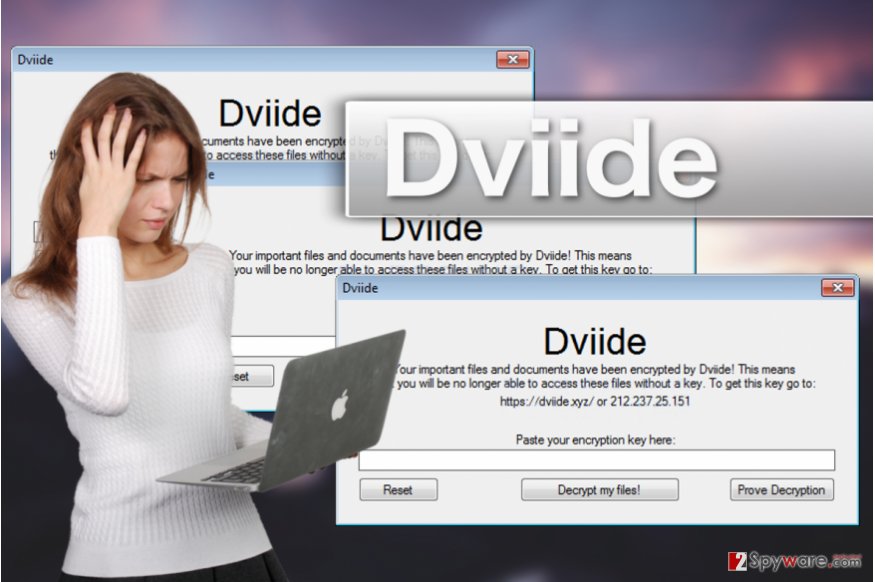Dviide ransomware / virus (Removal Guide) - Easy Removal Guide
Dviide virus Removal Guide
What is Dviide ransomware virus?
Dviide ransomware encrypts files and demands victims to purchase a decryption key
Dviide virus is a new crypto-ransomware [1] which sample has reached the cyber security experts just recently. After analyzing the sample, the experts have found that like most ransomware, this one appends files with specific types of extensions. In this case, all encrypted files will feature .dviide endings. It is currently unknown what specific encryption algorithm does this virus apply to the infected computer’s files, but it sure renders them inaccessible and unreadable. It is not too difficult to fall into panic when you suddenly come across such a situation on your computer. Dviide removal is definitely not the first thing that comes to mind, but data decryption is. The extortionists use this confusion to make some easy profit. They have programmed the virus in such a way so that when it is done encrypting files, it would automatically open a pop-up window with data recovery instructions. Below you can see the transcribed contents of this message:
Dviide
Your important files and documents have been encrypted by Dviide! This means
That you will be no longer able to access the files without a key. To get this key go to: https//dviide(dot)xyz/ or 212.237.25.151.Paste your encryption key here:
[ ]
“Reset button” “Decrypt my files!” Button “Prove Decryption’ button

This ransom note is rather brief compared to the messages other ransomware developers typically leave on the affected devices. Nevertheless, we can presume that the criminals deliberately reveal as little information as possible to protect their identities and sift out potential ransom payers from the nosy researchers who aim to learn more about the virus. Our advice is not to succumb to the criminal’s’ demands, regardless of how important the encrypted files may be. You may be able to recover your data with some free decryption tool in the future, but the money you give away to the cyber criminals will never be returned. So, you should think carefully which path to take. Either way, you will have to remove Dviide from your computer in the end, so that it would not encrypt your files repeatedly. Antivirus software such as FortectIntego will help you find and eliminate all virus components from the infected device.

The multiple ways ransomware infiltrate computers
Ransomware is probably the most versatile parasite when it comes to the ways of its distribution. It is possible for Dviide to infiltrate computers by exploiting their vulnerabilities such as outdated software or unpatched operating system [2]. Also, you may often find malicious ransomware files being spread through spam campaigns. Finally, you may get infected by this nasty infection after clicking on some deceptive online advertising. Having in mind the multiplicity of Dviide infiltration channels, it is quite difficult to predict from which direction the virus is going to hit. Thus, we strongly suggest you protect your personal data by saving backup copies of your files somewhere where the ransomware could not reach them.
Tips for the Dviide removal
Regardless of whether you choose to pay for the decryption your files or not, you must remove Dviide virus from your computer to prevent further damage to the system. You should start off by launching your PC in Safe Mode to disable some of the virus functionalities which may prevent your antivirus from properly eliminating the virus from your system. When the computer boots in the Safe Mode, you may then proceed with Dviide removal and run a system scan with the security utility.
Getting rid of Dviide virus. Follow these steps
Manual removal using Safe Mode
If you are unsure how to access the Safe Mode, follow the guidelines below:
Important! →
Manual removal guide might be too complicated for regular computer users. It requires advanced IT knowledge to be performed correctly (if vital system files are removed or damaged, it might result in full Windows compromise), and it also might take hours to complete. Therefore, we highly advise using the automatic method provided above instead.
Step 1. Access Safe Mode with Networking
Manual malware removal should be best performed in the Safe Mode environment.
Windows 7 / Vista / XP
- Click Start > Shutdown > Restart > OK.
- When your computer becomes active, start pressing F8 button (if that does not work, try F2, F12, Del, etc. – it all depends on your motherboard model) multiple times until you see the Advanced Boot Options window.
- Select Safe Mode with Networking from the list.

Windows 10 / Windows 8
- Right-click on Start button and select Settings.

- Scroll down to pick Update & Security.

- On the left side of the window, pick Recovery.
- Now scroll down to find Advanced Startup section.
- Click Restart now.

- Select Troubleshoot.

- Go to Advanced options.

- Select Startup Settings.

- Press Restart.
- Now press 5 or click 5) Enable Safe Mode with Networking.

Step 2. Shut down suspicious processes
Windows Task Manager is a useful tool that shows all the processes running in the background. If malware is running a process, you need to shut it down:
- Press Ctrl + Shift + Esc on your keyboard to open Windows Task Manager.
- Click on More details.

- Scroll down to Background processes section, and look for anything suspicious.
- Right-click and select Open file location.

- Go back to the process, right-click and pick End Task.

- Delete the contents of the malicious folder.
Step 3. Check program Startup
- Press Ctrl + Shift + Esc on your keyboard to open Windows Task Manager.
- Go to Startup tab.
- Right-click on the suspicious program and pick Disable.

Step 4. Delete virus files
Malware-related files can be found in various places within your computer. Here are instructions that could help you find them:
- Type in Disk Cleanup in Windows search and press Enter.

- Select the drive you want to clean (C: is your main drive by default and is likely to be the one that has malicious files in).
- Scroll through the Files to delete list and select the following:
Temporary Internet Files
Downloads
Recycle Bin
Temporary files - Pick Clean up system files.

- You can also look for other malicious files hidden in the following folders (type these entries in Windows Search and press Enter):
%AppData%
%LocalAppData%
%ProgramData%
%WinDir%
After you are finished, reboot the PC in normal mode.
Remove Dviide using System Restore
In case the Safe Mode is not effective in decontaminating the virus, you may try the following procedure:
-
Step 1: Reboot your computer to Safe Mode with Command Prompt
Windows 7 / Vista / XP- Click Start → Shutdown → Restart → OK.
- When your computer becomes active, start pressing F8 multiple times until you see the Advanced Boot Options window.
-
Select Command Prompt from the list

Windows 10 / Windows 8- Press the Power button at the Windows login screen. Now press and hold Shift, which is on your keyboard, and click Restart..
- Now select Troubleshoot → Advanced options → Startup Settings and finally press Restart.
-
Once your computer becomes active, select Enable Safe Mode with Command Prompt in Startup Settings window.

-
Step 2: Restore your system files and settings
-
Once the Command Prompt window shows up, enter cd restore and click Enter.

-
Now type rstrui.exe and press Enter again..

-
When a new window shows up, click Next and select your restore point that is prior the infiltration of Dviide. After doing that, click Next.


-
Now click Yes to start system restore.

-
Once the Command Prompt window shows up, enter cd restore and click Enter.
Bonus: Recover your data
Guide which is presented above is supposed to help you remove Dviide from your computer. To recover your encrypted files, we recommend using a detailed guide prepared by 2-spyware.com security experts.If your files are encrypted by Dviide, you can use several methods to restore them:
How to use DataRecoveryPro to recover files encrypted by Dviide
Here you will find instructions how to use the DataRecoveryPro tool to decrypt some of the files which have been encrypted by this ransomware
- Download Data Recovery Pro;
- Follow the steps of Data Recovery Setup and install the program on your computer;
- Launch it and scan your computer for files encrypted by Dviide ransomware;
- Restore them.
Windows Previous Versions feature usage instructions
If you have never used Windows Previous Versions feature before, we recommend following these guidelines here:
- Find an encrypted file you need to restore and right-click on it;
- Select “Properties” and go to “Previous versions” tab;
- Here, check each of available copies of the file in “Folder versions”. You should select the version you want to recover and click “Restore”.
Recover files with the help of ShadowExplorer
Data recovery using ShadowExplorer is not complicated. All you have to do is follow these simple steps:
- Download Shadow Explorer (http://shadowexplorer.com/);
- Follow a Shadow Explorer Setup Wizard and install this application on your computer;
- Launch the program and go through the drop down menu on the top left corner to select the disk of your encrypted data. Check what folders are there;
- Right-click on the folder you want to restore and select “Export”. You can also select where you want it to be stored.
Finally, you should always think about the protection of crypto-ransomwares. In order to protect your computer from Dviide and other ransomwares, use a reputable anti-spyware, such as FortectIntego, SpyHunter 5Combo Cleaner or Malwarebytes
How to prevent from getting ransomware
Access your website securely from any location
When you work on the domain, site, blog, or different project that requires constant management, content creation, or coding, you may need to connect to the server and content management service more often. The best solution for creating a tighter network could be a dedicated/fixed IP address.
If you make your IP address static and set to your device, you can connect to the CMS from any location and do not create any additional issues for the server or network manager that needs to monitor connections and activities. VPN software providers like Private Internet Access can help you with such settings and offer the option to control the online reputation and manage projects easily from any part of the world.
Recover files after data-affecting malware attacks
While much of the data can be accidentally deleted due to various reasons, malware is one of the main culprits that can cause loss of pictures, documents, videos, and other important files. More serious malware infections lead to significant data loss when your documents, system files, and images get encrypted. In particular, ransomware is is a type of malware that focuses on such functions, so your files become useless without an ability to access them.
Even though there is little to no possibility to recover after file-locking threats, some applications have features for data recovery in the system. In some cases, Data Recovery Pro can also help to recover at least some portion of your data after data-locking virus infection or general cyber infection.
- ^ Crypto Ransomware. US-cert. United States Computer Emergency Readiness Team.
- ^ Nadia Kovacs. The importance of general software updates and patches. Norton. Norton Protection Blog.





















